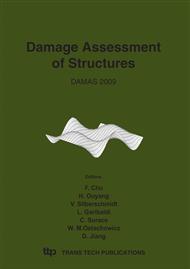p.741
p.749
p.757
p.767
p.775
p.785
p.793
p.803
p.811
A Method for Acoustic Emission Source Identification Based on Optimisation
Abstract:
When a metal or composite structure begins to fail, for example due to high cycle fatigue, acoustic emissions caused by the propagation of cracks give rise to bursts of ultrasonic waves travelling through the structure. The health of a structure can be monitored by means of sensors which detect these waves. Acoustic emissions are often generated in experiments by breaking a pencil lead against the surface of the structure in a standardised way but the forces that this imparts are not well understood at present. A Local Interaction Simulation Approach (LISA) algorithm has been implemented to simulate the propagation of ultrasonic waves. This code has been validated against experiments in previous work and has been shown to accurately reproduce the propagation of Lamb waves (including reflections and dispersion etc.) within thin-plate like structures. This paper deals with the use of the LISA code to characterise the forces associated with standard pencil lead breaks. The displacement due to waves emanating from a break is measured and a Differential Evolution (DE) optimisation scheme is used to find the optimal profile of forcing to match the simulation with experiment.
Info:
Periodical:
Pages:
793-801
Citation:
Online since:
June 2009
Authors:
Price:
Сopyright:
© 2009 Trans Tech Publications Ltd. All Rights Reserved
Share:
Citation:


